Introduction
There’s nothing quite like sinking your teeth into a perfectly smoked, fall-off-the-bone beef plate rib. Bursting with rich, beefy flavor and marbled with luscious fat, this lesser-known cut is gaining legendary status in the world of barbecue. While brisket and pork ribs have long held the spotlight, beef plate ribs—sometimes called “dino ribs” due to their massive size—are fast becoming the showstoppers on BBQ menus across the globe.
In this comprehensive guide, we’ll take you deep into the world of beef plate ribs—from what they are and how they differ from other beef cuts to how to select, season, and cook them like a pro. Whether you’re firing up a smoker, grilling outdoors, or using an oven, this step-by-step manual is packed with expert techniques, flavor hacks, and tips to help you serve mouth-watering plate ribs that impress even the most die-hard carnivores..Beef Chorizo
We’ll also answer your most pressing questions in our FAQ section, give you a buying guide for budget-conscious or premium shoppers, and share three helpful external resources that enhance your cooking journey. Whether you’re a backyard grill master or a first-timer looking to make an impression, this guide ensures your next plate of ribs is a culinary masterpiece.
But first, let’s start with a clear breakdown of what beef plate ribs really are and why they deserve a prime spot on your smoker rack.
What Are Beef Plate Ribs? (Defining the Cut & Difference from Beef Ribs)
Beef plate ribs are one of the most flavorful and richly marbled cuts in the world of barbecue. These ribs come from the lower section of the cow’s rib cage, known as the “short plate,” located just below the ribeye and brisket. When cooked properly, they yield a tender, juicy, and bold beef flavor that’s often compared to brisket—but with even more bone-in character.
Unlike back ribs, which are cut from the upper rib section near the spine and tend to have less meat, plate ribs are meatier, fattier, and thicker. A single plate rib can weigh over a pound and stretch nearly 8–12 inches in length, earning them the nickname “dino ribs” for their prehistoric appearance.
They’re typically cut as a three-bone slab, although butchers can also portion them individually. Known by professionals as “NAMP 123A” (the meat industry’s number for the cut), these ribs are especially popular in Texas-style barbecue and are gaining traction globally..Paraguayan Beef
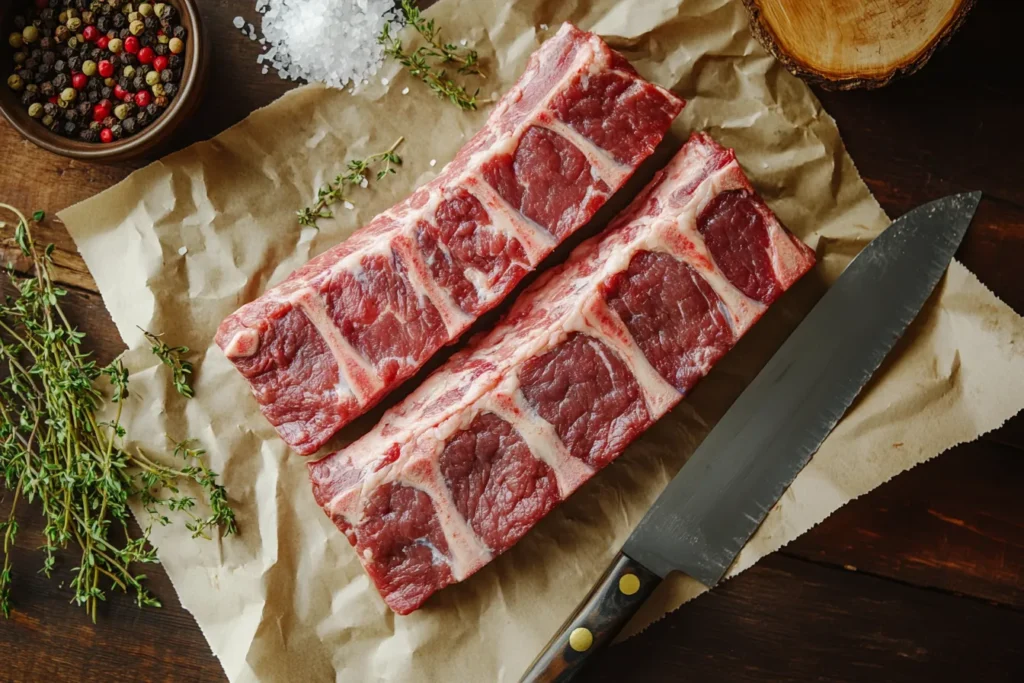
Anatomy & Butchery: Where Do Plate Ribs Come From?
Plate ribs are cut from the short plate primal, which sits just beneath the rib primal (ribeye area) and above the flank. This area bears a lot of weight and muscle activity, which results in intensely marbled meat with tough connective tissue that breaks down beautifully when slow-cooked.
Butchering the short plate involves careful trimming to retain the most tender sections. The meat sits on top of large, flat rib bones, which act as both heat insulators during cooking and dramatic visual anchors on the plate. Because of their size and complexity, plate ribs require long, slow cooking—usually via smoking or braising—to unlock their full potential.
Butchers may offer two variations:
- English Cut: The ribs are separated into individual bones.
- Plate Cut: The three ribs are kept together as a slab, ideal for smoking.
These ribs are often confused with other rib cuts, which brings us to the next point.
Plate vs. Short Ribs vs. Brisket: A Quick Comparison
Understanding the difference between beef cuts is crucial for choosing the right preparation and flavor experience:
| Cut | Location | Texture | Ideal Cooking Method | Flavor Profile |
|---|---|---|---|---|
| Plate Ribs | Short plate (belly) | Marbled, dense | Smoking, slow roast | Beefy, rich, smoky |
| Short Ribs | Chuck or Plate | Meaty, moderately tough | Braise or smoke | Savory, hearty |
| Brisket | Lower chest | Tough, fibrous | Long smoke or sous-vide | Bold, fatty, tender |
Plate ribs differ from short ribs primarily in their bone size, meat thickness, and preparation style. Short ribs may be braised more often, while plate ribs shine in the smoker for 6–8 hours. Brisket, while similar in flavor, lacks the dramatic visual appeal and bone-in experience of plate ribs.
By understanding these subtle differences, you’ll not only cook better ribs—you’ll also buy smarter and impress guests with your knowledge at the next barbecue.
Why Beef Plate Ribs Are Trending in Barbecue Culture
In recent years, beef plate ribs have made their way from niche butcher shops to the spotlight of BBQ competitions, YouTube channels, and food blogs. But what’s behind this meaty movement? The trend can be attributed to a combination of factors: spectacle, flavor, and authenticity.
First, these ribs are visually stunning. Their enormous bones and thick meat cap create that Instagram-worthy “dino rib” look that social media adores. Pitmasters and backyard BBQ lovers alike showcase them with pride, creating a buzz that rivals even brisket or pulled pork.
Second, beef plate ribs deliver unbeatable flavor. Thanks to their marbling and bone-in structure, they offer a juicy, smoky taste that’s hard to match. As more people crave rich, authentic, slow-smoked meats, plate ribs have surged in popularity for their bold taste and impressive presentation.
Lastly, the growth of Texas-style barbecue and the focus on primal, ancestral cuts have brought beef ribs into the culinary spotlight. From food trucks in Austin to backyard smokers in suburban neighborhoods, plate ribs are carving their way into mainstream menus.
Flavor Profile & Marbling
If you’re after a beef experience that’s intensely juicy, tender, and savory, plate ribs are the way to go. These ribs contain a high percentage of intramuscular fat (marbling), which renders slowly during cooking, keeping the meat moist and flavorful.
The smoke-loving texture of the meat holds rubs and spice blends exceptionally well, and the proximity to the bone intensifies the richness—often described as “beefier than brisket.”
Popular with dry rubs, plate ribs pair well with classic Texas seasonings: kosher salt, cracked black pepper, paprika, and garlic powder. You can also layer them with international flavors like Korean BBQ glazes or Latin American spice pastes, thanks to their versatility..Beef Jerky Recipe
Cost and Availability
While plate ribs were once difficult to find, they’re now more accessible thanks to increased demand. You can expect to pay anywhere from $7 to $12 per pound, depending on the grade and region. Higher-end cuts like Prime or Wagyu can cost more but offer exceptional tenderness and flavor.
Availability may still vary, especially at standard grocery chains. For the best selection, check:
- Local butcher shops (ask for “plate ribs” or “NAMP 123A”)
- Specialty meat markets or BBQ supply stores
- Online meat delivery services that offer specialty cuts
Because of their large size, even one or two ribs per person can be enough, making them a surprisingly cost-effective option for serving a crowd.
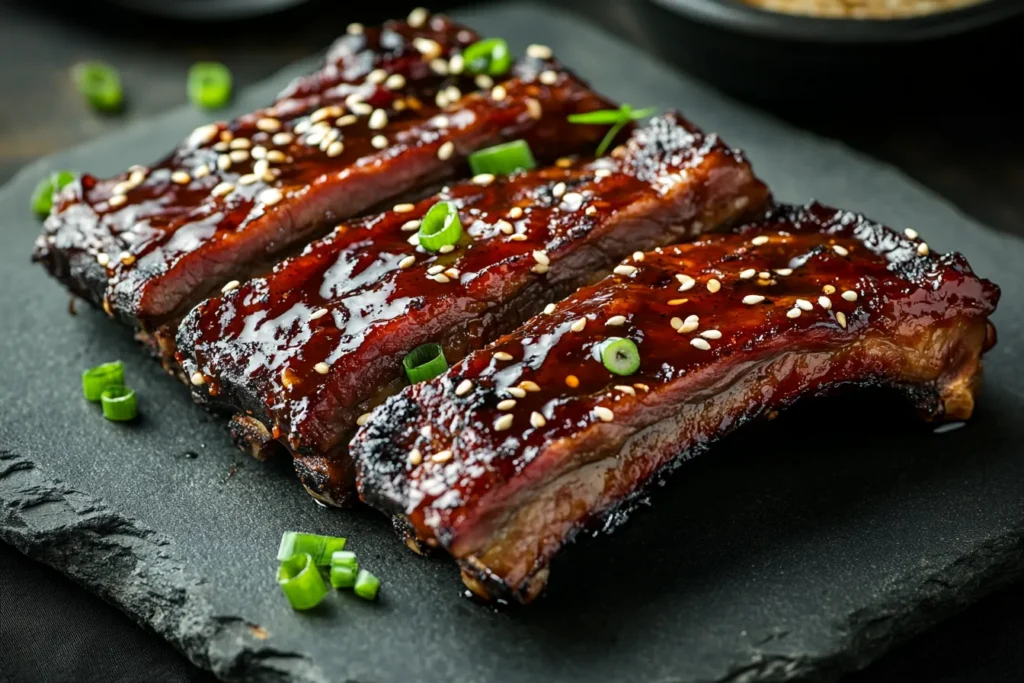
Selecting the Best Beef Plate Ribs at the Store or Butcher
Picking the right ribs is crucial for a successful cook. Here’s what to look for:
USDA Grades and What to Look For
Always aim for USDA Prime or Choice grade ribs. Prime ribs offer more marbling, which ensures tenderness and flavor during long, slow cooks. If you can’t find Prime, Choice is an excellent alternative and still produces great results.
When inspecting ribs:
- Look for thick meat on top of the bone, not between the bones.
- The bones should be uniform in size and not broken or splintered.
- Meat should appear bright red, not dull or discolored.
Bone-In vs Boneless Plate Ribs: Pros and Cons
While bone-in plate ribs are the traditional favorite (and the most flavorful), some markets offer boneless plate short ribs. These are easier to portion and cook in smaller kitchens but sacrifice presentation and the bone-enhanced flavor.
| Type | Pros | Cons |
|---|---|---|
| Bone-In | Flavor, visual appeal, authenticity | Takes up more space, cooks slower |
| Boneless | Easier to handle, faster cooking | Less flavor depth, lacks dramatic look |
For most BBQ setups, bone-in is the preferred choice, especially when smoking or slow-roasting.
Preparation: Trimming, Seasoning & Injecting Techniques
Getting beef plate ribs ready for the smoker is as much an art as the cooking itself. Proper preparation sets the stage for perfect bark, juicy interior, and bold flavor.
How to Trim Fat Cap Properly
When you buy plate ribs, they often come with a fat cap and silverskin on top. While fat renders during cooking, too much can block rub penetration and lead to chewy bites.
- Trim the fat cap down to about 1/4 inch to allow seasoning to penetrate while retaining enough fat for moisture.
- Remove any silverskin or membrane from the meat side. This connective tissue doesn’t break down easily and can make ribs tough.
- Leave the bone side intact, especially if smoking. The bones protect the meat and enhance flavor.
Dry Rub Ingredients & Layering Techniques
A strong dry rub is crucial for flavor and bark development. You can go classic or creative, depending on your taste.
Basic Texas-style rub (recommended for beginners):
- 2 parts kosher salt
- 2 parts coarse black pepper
- 1 part garlic powder
- 1 part smoked paprika
- Optional: a pinch of cayenne or onion powder
Layering tips:
- Pat the meat dry before applying rub.
- Rub in olive oil or mustard as a binder.
- Apply rub generously and evenly on all sides at least 30 minutes before cooking (or overnight for more flavor).
Optional Brine or Injection for Moistness
To elevate juiciness and internal flavor, especially for long cooks, consider injecting your ribs.
Common beef injections include:
- Beef broth + melted butter + Worcestershire
- Apple cider vinegar + garlic + herbs
- Soy sauce + brown sugar + stock
Inject with a meat injector across the thickest parts, avoiding the bone.
Alternatively, wet brining for 6–12 hours in a saltwater solution with aromatics can improve internal moisture. However, this method is less common for ribs compared to poultry.
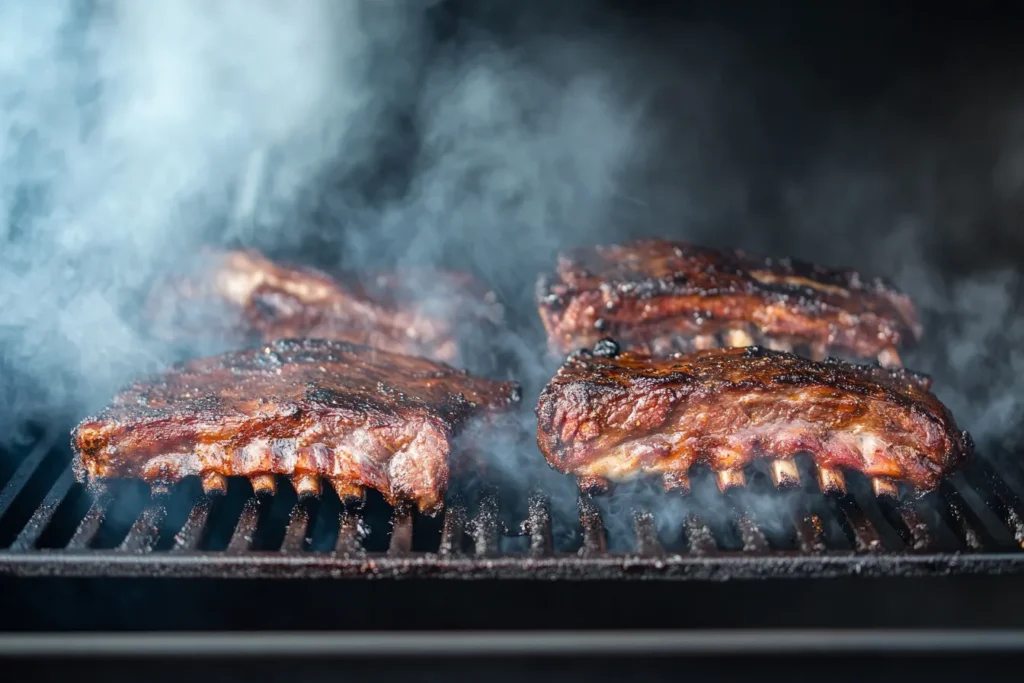
Smoking Beef Plate Ribs: Step-by-Step Smoker Guide
Beef plate ribs were made for the smoker. The low-and-slow method renders fat, tenderizes collagen, and infuses rich smoky flavor.
Best Wood Types: Oak, Hickory, Mesquite
Different woods bring out different profiles:
| Wood Type | Flavor Profile | Best For |
|---|---|---|
| Oak | Mild, balanced, traditional | Texas-style BBQ |
| Hickory | Strong, bold, bacon-like | Deep Southern flavor |
| Mesquite | Intense, earthy | Use in moderation for smoky ribs |
A good tip: Start with oak as a base and add a small amount of hickory or mesquite for complexity.
Temperature Targets and Time Estimates
Set your smoker to 250°F (121°C) and allow for 6–8 hours of cooking, depending on rib size and thickness.
Key targets:
- Internal meat temperature: 203°F (95°C) for ultimate tenderness
- Wrap in butcher paper at 165°F (74°C) to push through the stall and preserve bark
The “Stall” Explained and How to Manage It
The stall happens around 160–170°F (71–77°C), when evaporating moisture cools the meat. It can last 1–2 hours and drive beginners crazy.
Solutions:
- Wrap ribs in butcher paper or foil once you hit stall temps
- Add a water pan to the smoker for ambient humidity
- Avoid constantly opening the lid; trust the thermometer!
Rest your ribs for at least 30 minutes post-cooking, wrapped and insulated. This allows juices to redistribute and makes slicing easier.
Grilling or Oven-Braising (Alternative Methods)
While smoking is the gold standard for beef plate ribs, you can still enjoy great results using your oven or grill, especially when smoking isn’t an option.
Reverse Sear on Grill
For grill lovers, the reverse sear method gives you bark and tenderness with a crisp finish.
Steps:
- Season ribs with dry rub and rest for 30–60 minutes.
- Cook over indirect heat at around 275°F (135°C) for 4–5 hours.
- When the internal temperature reaches 190°F (88°C), move ribs to direct heat for a 5-minute sear on each side.
- Monitor closely to avoid flare-ups from fat drippings.
This method develops a deep crust and preserves juicy meat without a smoker.
Oven-Braised, Then Broiled for Bark
If you’re cooking indoors, oven-braising mimics the tenderness of smoking—especially useful for winter cooks.
Steps:
- Preheat oven to 300°F (150°C).
- Place ribs in a roasting pan with 1 inch of beef broth, beer, or red wine.
- Cover tightly with foil and bake for 4–5 hours.
- Remove foil and broil on high for 5–7 minutes to form bark.
- Let rest before slicing.
Pro tip: Add herbs, garlic, or onion to the braising liquid for added depth.
Resting, Slicing & Serving Like a Pro
Ideal Resting Time & Foil Wrap
Resting is essential to avoid dry or unevenly cooked ribs. After removing from heat:
- Wrap ribs loosely in butcher paper or foil.
- Let rest in a cooler or room temp tray for 30–45 minutes.
- This helps redistribute juices and firms up the bark.
Avoid slicing immediately—it’s worth the wait.
Slicing Angle for Maximum Tenderness
Use a sharp slicing knife to cut between bones:
- Turn the ribs bone side up to clearly see the gaps.
- Slice perpendicular to the bone to preserve structure.
- Serve thick slices, ideally one bone per serving for presentation and satisfaction.
Recommended Sides & Plating Presentation
Pairing matters. These ribs shine best alongside hearty and bold sides:
- Smoked mac & cheese
- Grilled corn on the cob
- Tangy coleslaw
- Pickled red onions or jalapeños
- Garlic mashed potatoes
Plate ribs vertically over a wooden board or rustic tray for that “steakhouse-meets-backyard” effect.
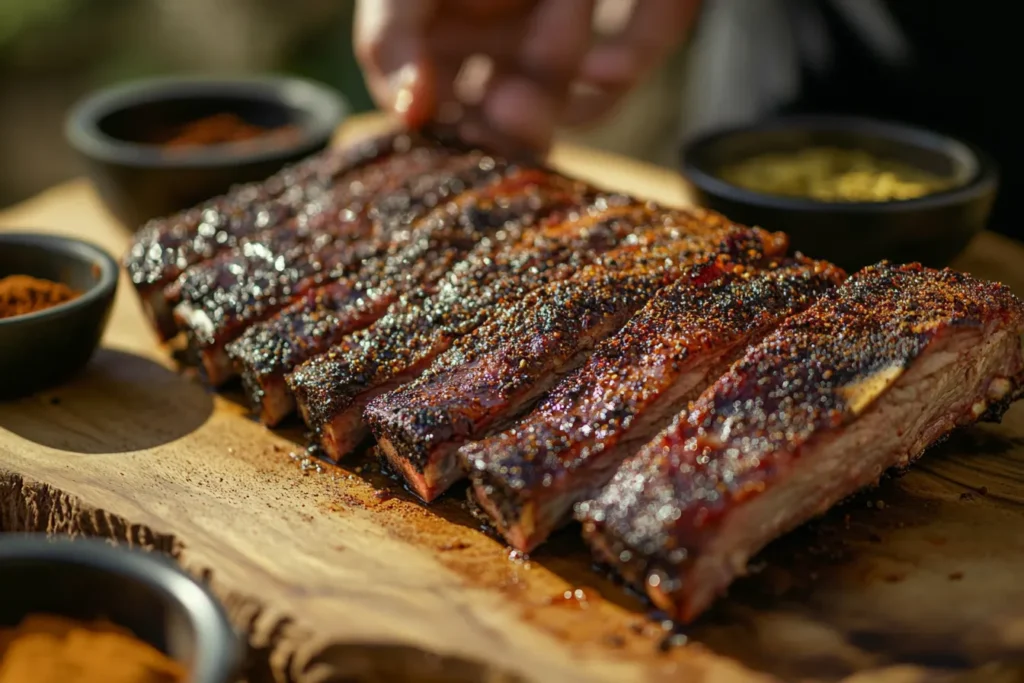
Flavor Variations: Regional Rubs, Marinades & Sauces
Beef plate ribs can carry a variety of global flavors thanks to their rich base.
Texas-Style Dry Rub
The classic: Salt, pepper, garlic, paprika. Often smoked over post oak and served dry with sauce on the side.
Tip: Finish with a splash of apple cider vinegar before serving to cut the richness.
Korean BBQ Gochujang Glaze
For a bold twist:
- Marinade: Soy sauce, gochujang, honey, garlic, sesame oil
- Finish with a brush of glaze in the last 30 minutes of cooking
- Garnish with green onion and sesame seeds
Pairs well with sticky rice or kimchi.
Argentine Chimichurri Topping
Light, herbal and acidic, chimichurri is the perfect counterpoint to the rib’s richness.
- Blend: Fresh parsley, garlic, red chili, red wine vinegar, olive oil
- Spoon generously over sliced ribs before serving
Nutrition Insights: Calories, Protein, Fat Content
Beef plate ribs are nutrient-dense and protein-rich, though they come with a notable fat content due to their marbling.
Per 100g of cooked beef plate ribs (approximate):
- Calories: 300–400 kcal
- Protein: 22–25g
- Fat: 25–30g (including 10–12g saturated fat)
- Iron: 2.6 mg
- Zinc: 6.4 mg
These ribs are ideal for low-carb or keto diets but should be consumed in moderation due to their high fat content.
Buying & Pricing Guide: What to Expect
Price Per Pound Comparison with Brisket
Beef plate ribs typically cost between $7 and $12 per pound, depending on grade and sourcing. By comparison:
- Brisket: $5–$10/lb
- Short ribs (English cut): $8–$14/lb
Though pricier than brisket, plate ribs offer more dramatic presentation and richer meat-to-bone ratios.
How Many Plates to Buy for a Crowd
A typical plate rib weighs around 1–1.5 pounds, bone-in.
Serving suggestion:
- 1 rib per adult (meaty and filling)
- For large groups, aim for half a pound of meat per person, factoring in bone weight
Where to Buy: Butchers, Online Meat Delivery & Farmers Markets
You can find high-quality beef plate ribs at:
- Specialty butchers: Always ask for “plate ribs” or “123A cut”
- Online delivery: Sites like Porter Road, Snake River Farms, and Crowd Cow
- Farmers markets: Great for grass-fed or pasture-raised options
Buy fresh when possible, but plate ribs freeze well for up to 6 months.
Frequently Asked Questions (FAQs)
Are beef plate ribs the same as short ribs?
No. Plate ribs come from the short plate section; short ribs typically come from the chuck or rib area and are smaller.
Can I cook them in an oven only?
Yes. Oven-braising followed by a broil creates tender ribs with a crisp bark—great alternative to smoking.
How long do they keep in the fridge?
Cooked ribs last 3–4 days refrigerated. Uncooked, they last 3–5 days if vacuum-sealed.
What internal temperature indicates doneness?
Target 203°F (95°C) for fall-off-the-bone tenderness.
Can plate ribs be frozen?
Yes. Freeze raw or cooked ribs for up to 6 months. Thaw in the fridge 24 hours before reheating or cooking.
Best side dishes to pair with plate ribs?
Try:
- Smoked mac & cheese
- Grilled vegetables
- Coleslaw or pickled veggies
- Garlic mashed potatoes
Conclusion & Final Takeaways
Beef plate ribs are the hidden gem of the barbecue world. With proper preparation, thoughtful seasoning, and low-and-slow cooking, you can create a dish that’s both impressive and incredibly satisfying.
Whether you’re smoking them Texas-style, braising them indoors, or exploring global flavor twists, these ribs offer a culinary experience that few other cuts can match. Invest in high-quality meat, give yourself time, and trust the process—you’ll be rewarded with the most delicious, tender, and flavorful ribs you’ve ever tasted.
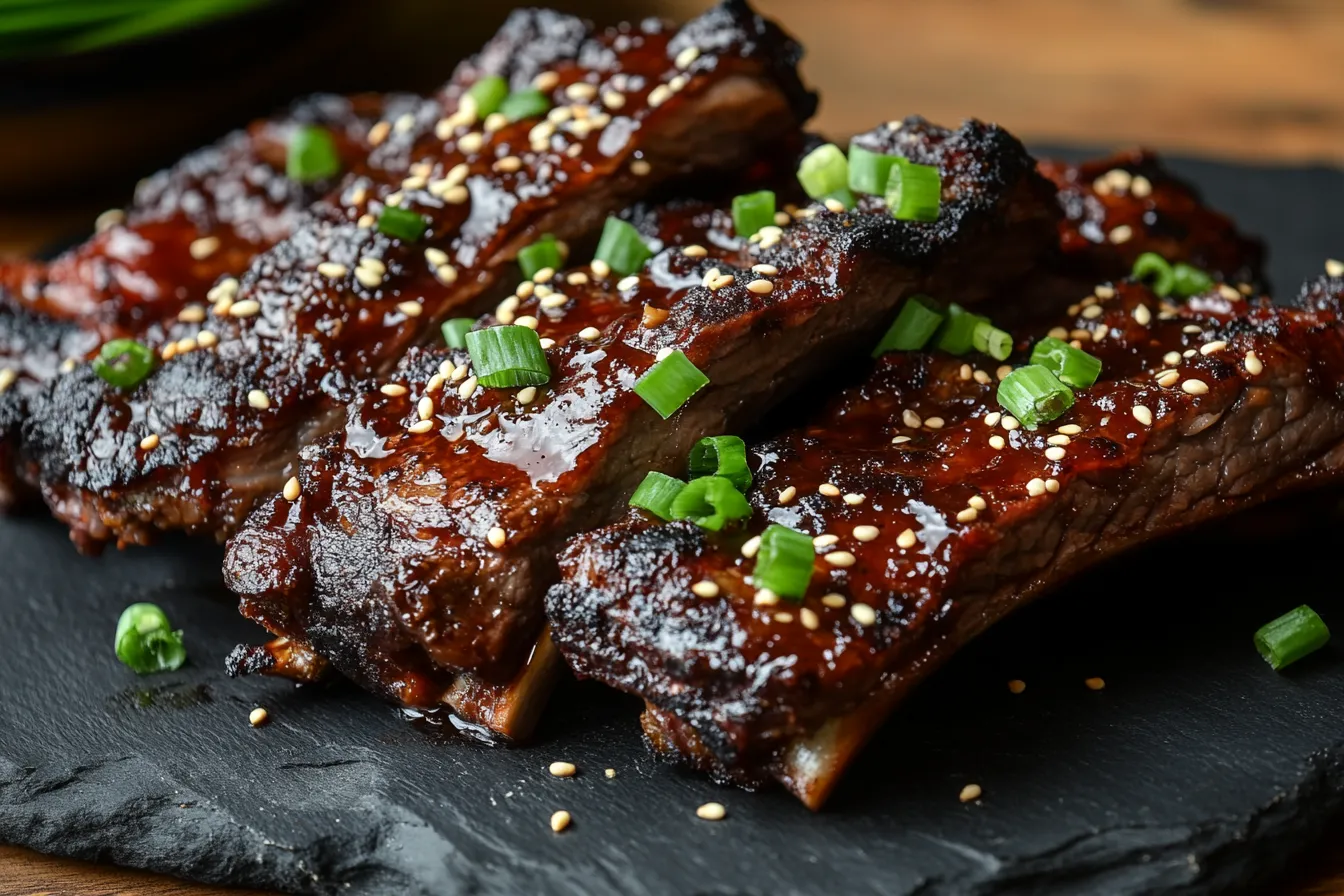
Name: Smoked Beef Plate Ribs
Ingredients
Equipment
Method
- Instructions:
- Trim excess fat and silverskin from ribs, leaving about 1/4 inch of fat.
- Pat ribs dry, apply binder, then coat evenly with rub on all sides.
- (Optional) Inject ribs with the prepared mixture evenly across the meat.
- Preheat smoker to 250°F (121°C) using oak or hickory wood.
- Place ribs bone-side down and smoke for 3–4 hours unwrapped.
- Spritz every hour with water or apple cider vinegar.
- At 165°F internal temp, wrap ribs in butcher paper and continue smoking.
- Smoke until ribs reach 203°F (95°C), about 6–8 hours total.
- Remove, rest wrapped for 30–45 minutes, then slice between bones and serve.
